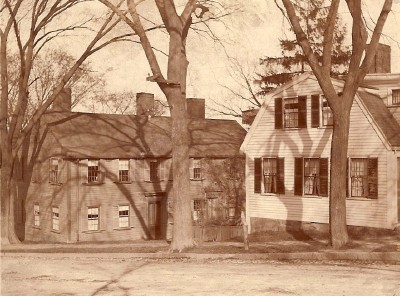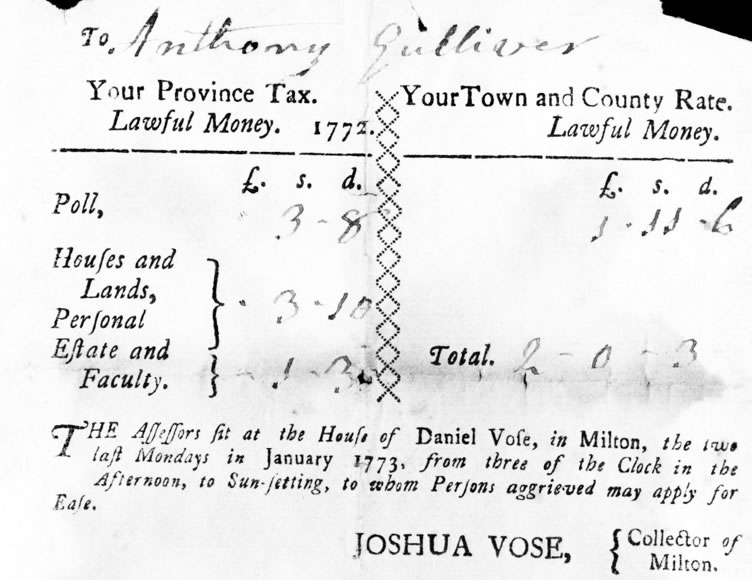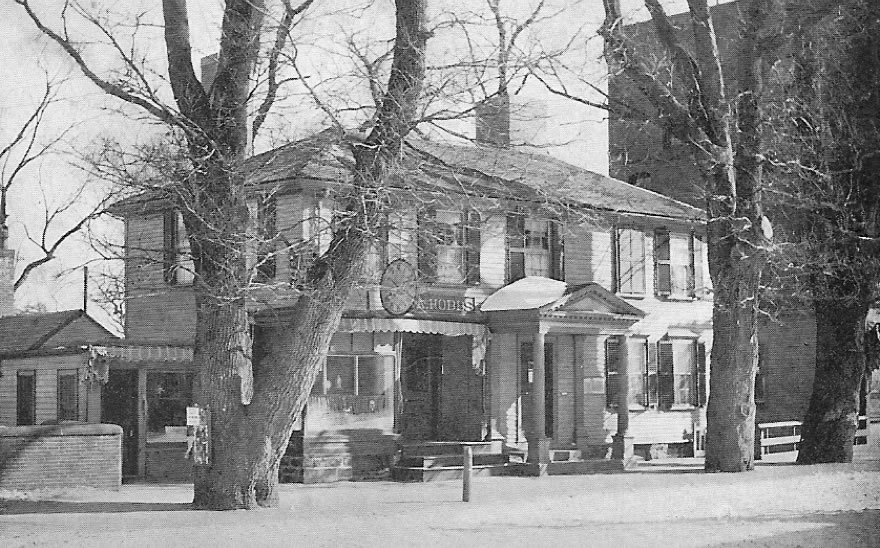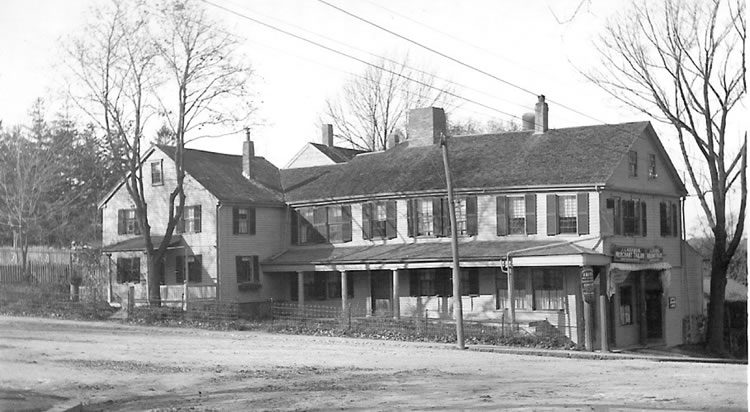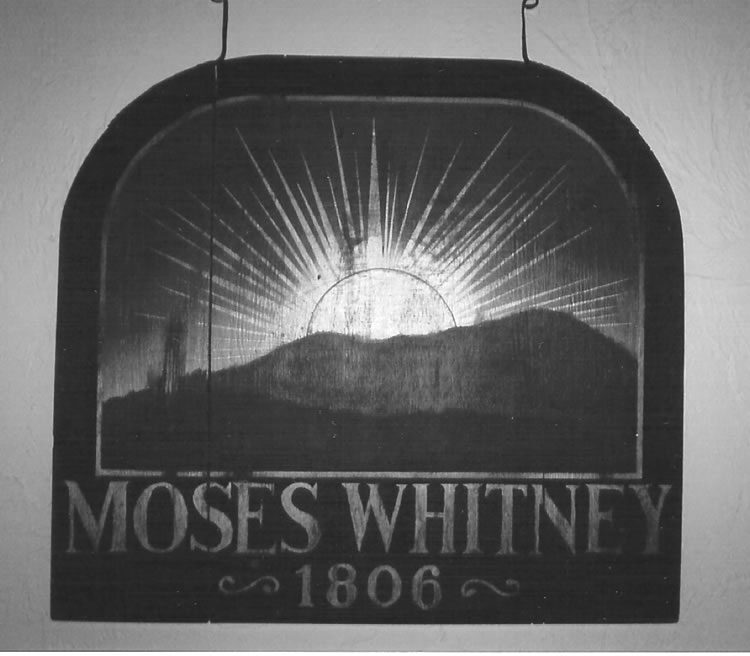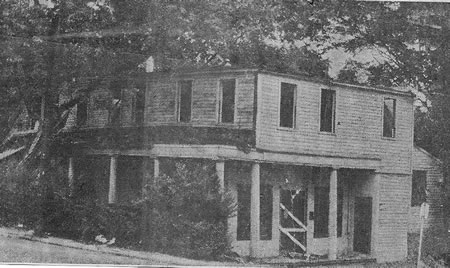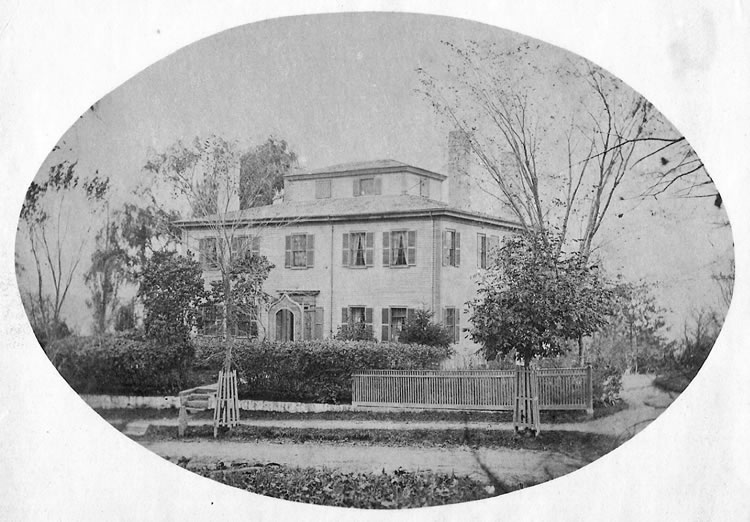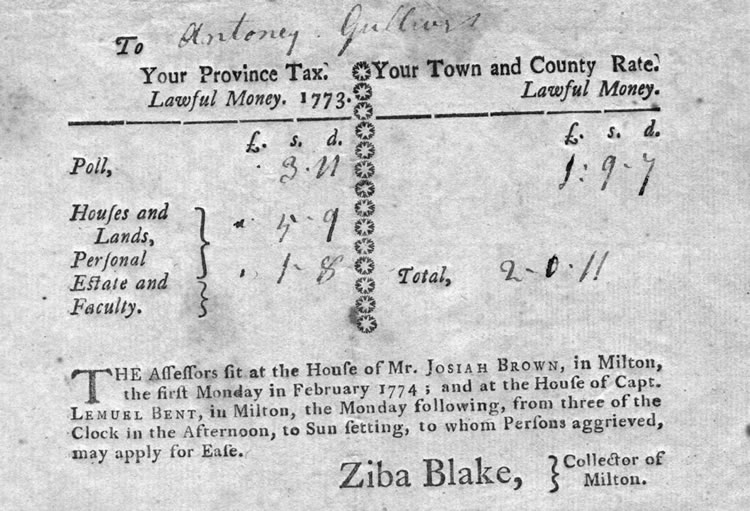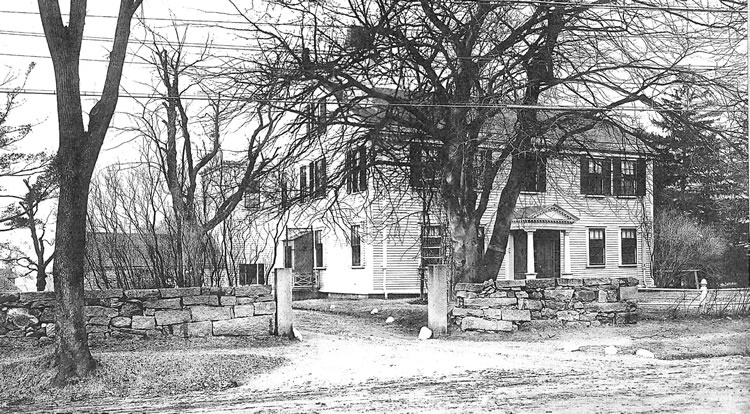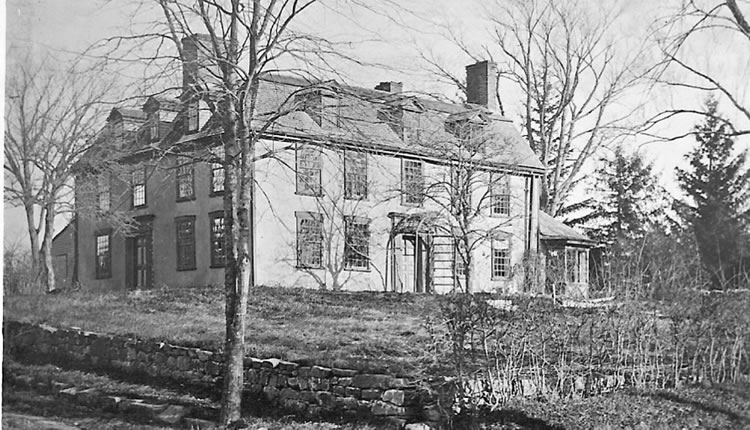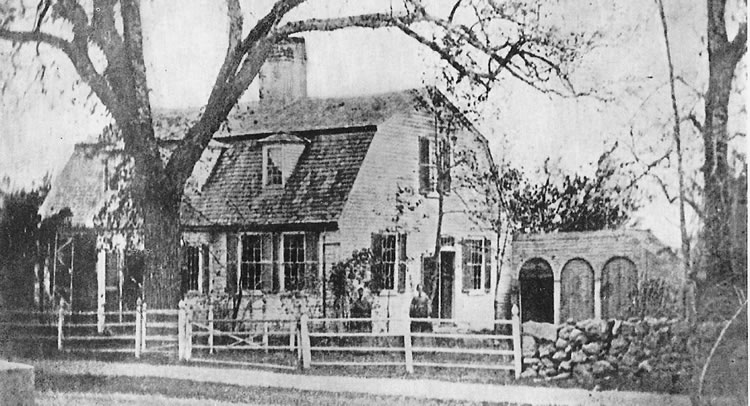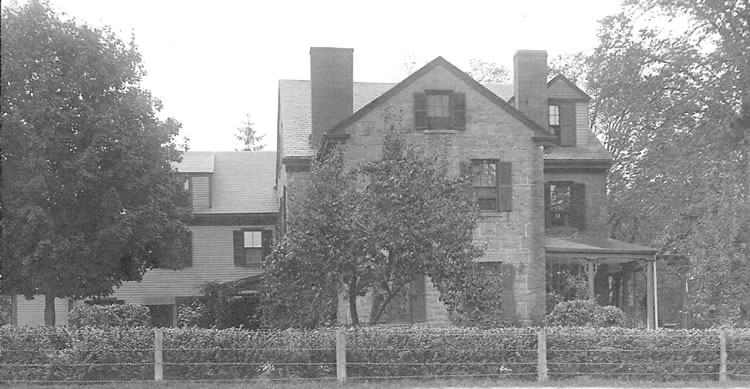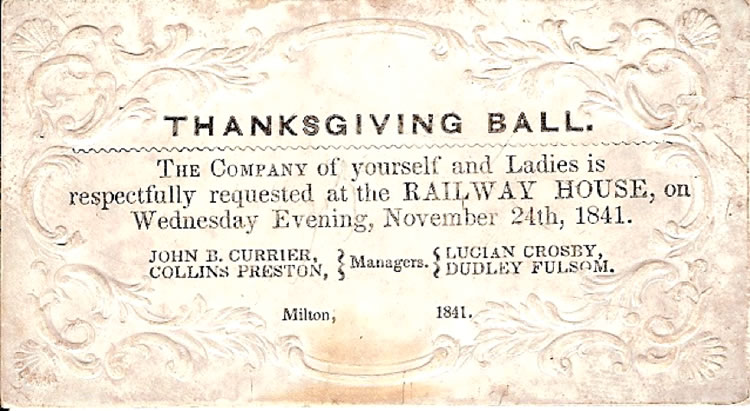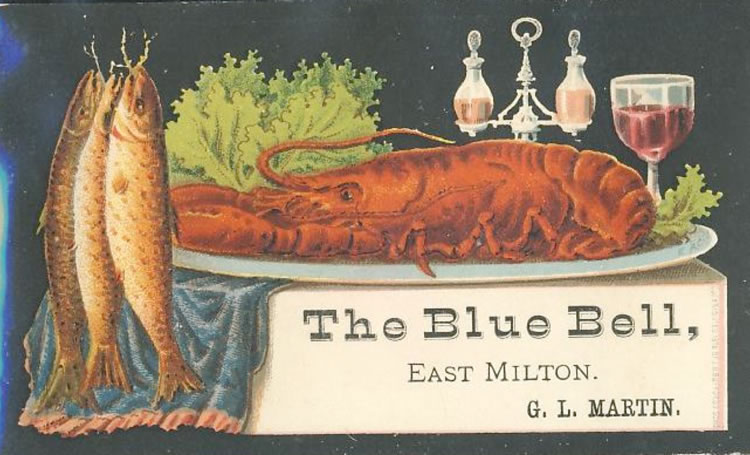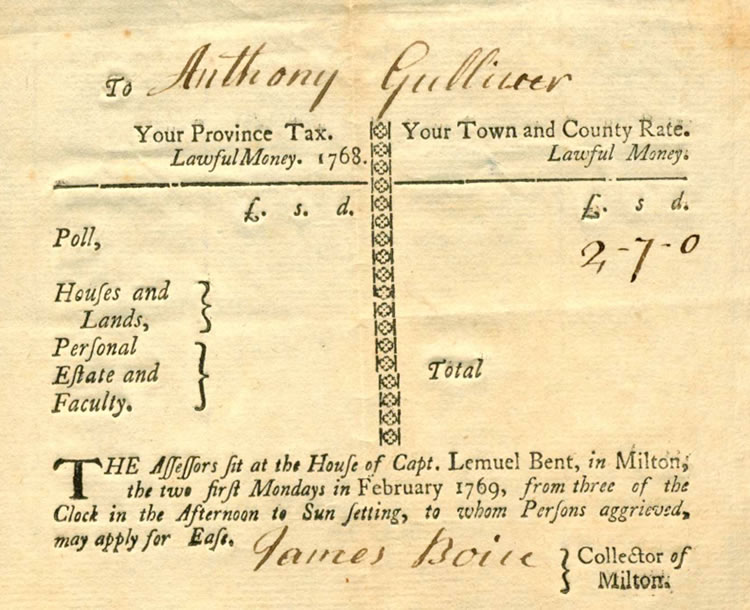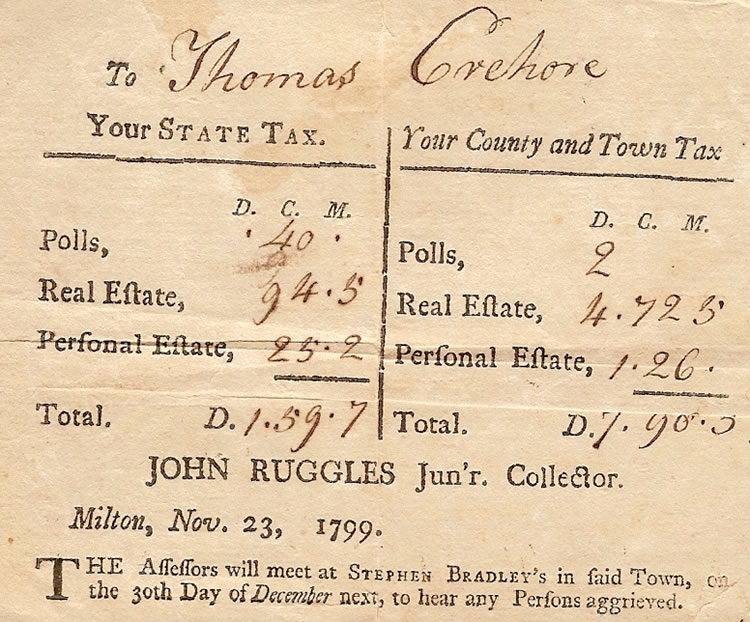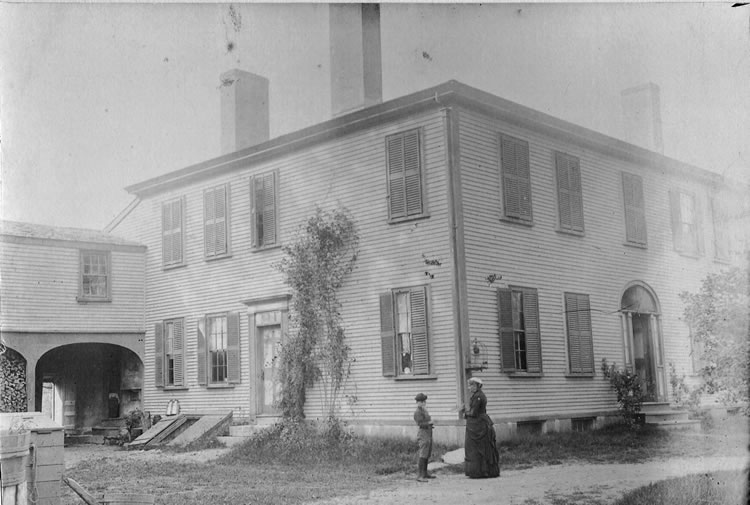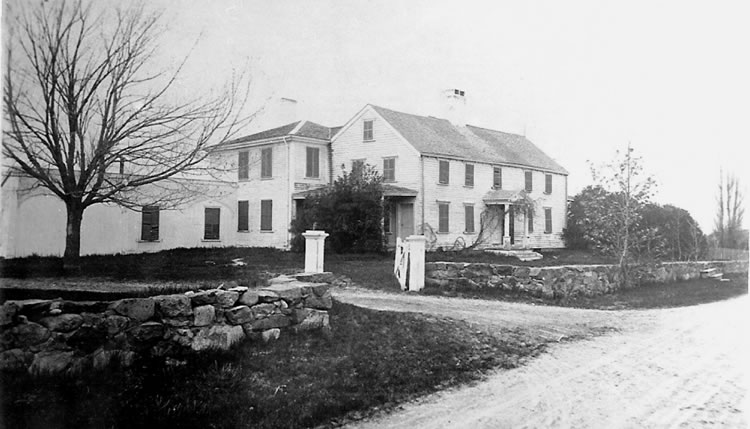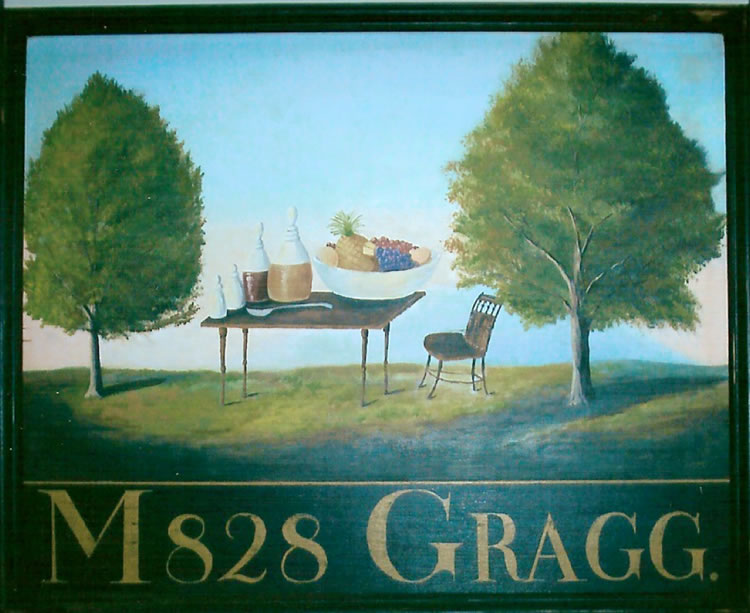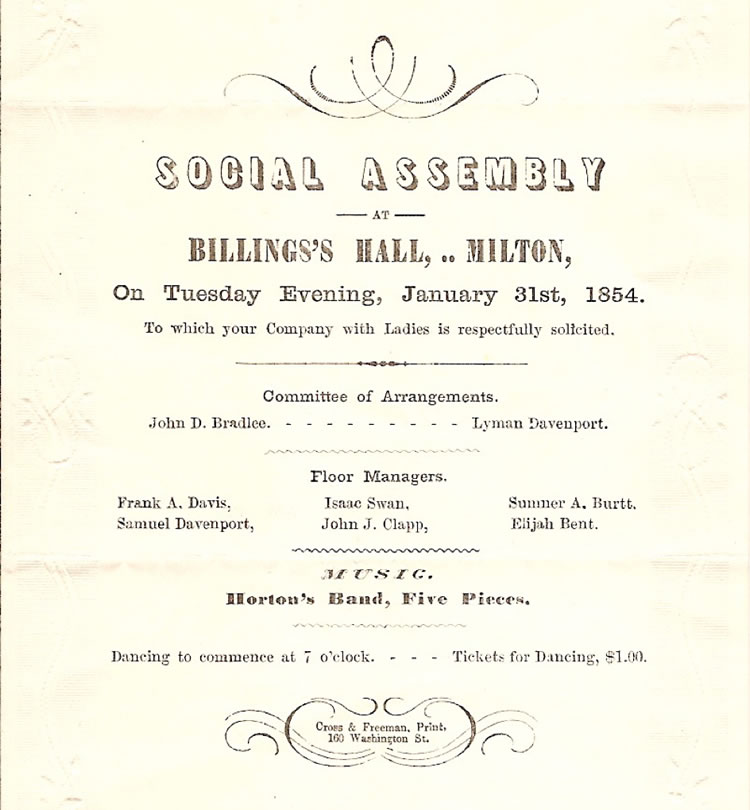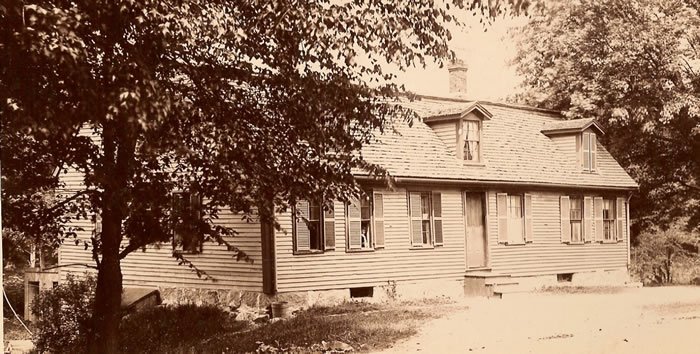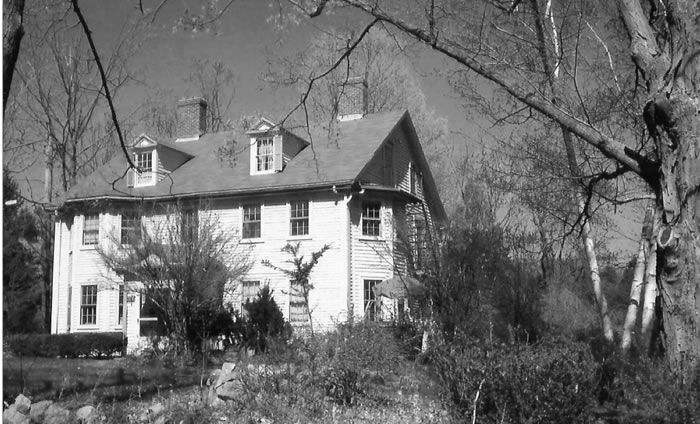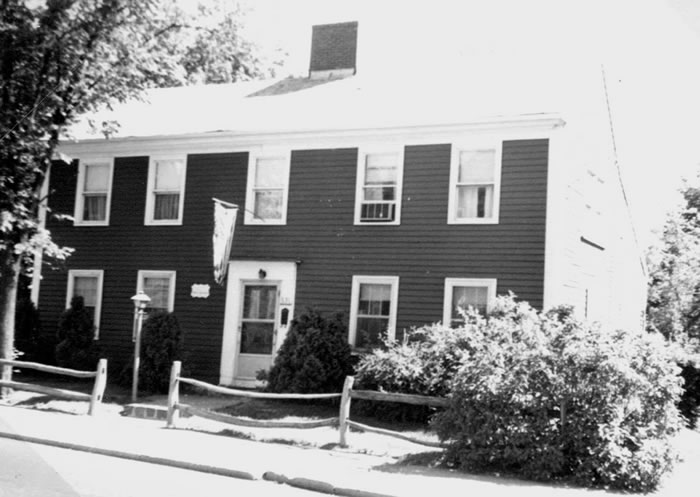
|
|
Milton Tavern Days by Linda Mason Pirie "There is nothing which has yet been contrived by man, by which so much happiness is produced as by a good tavern or inn." — Samuel Johnson Shortly after the establishment of Massachusetts Bay Colony in 1630 the court required that every town have a public house or 'ordinary' to entertain strangers. A citizen of Milton, or any town, was prohibited from entertaining a stranger in his home unless he gave a bond or surety for his guest's good behavior, thus making the local tavern a necessity. These early public houses were required by law to be located near the church; thus allowing church leaders to keep a watchful eye on its activities and making sure no one kept tavern during church meetings! In addition to food and lodging the innkeeper "often led the singing in the meeting house on Sunday; acted as the school master for children of those who frequented his house; served in the legislature or held town office; ruled over the local courts; and often ran the local ferry! His role was not easy -- he could be fined if he sold a person too much liquor OR if he refused to sell the amount allowed by law. 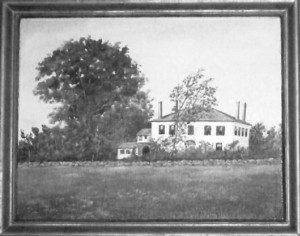
For a number of years taxes were collected at the local tavern. A Milton resident could enjoy a drink at the public house of Minot Thayer, Daniel Vose, Capt. Lemuel Bent, Josiah Brown or at the Tavern of Mrs. Atherton (at left) and pay taxes at the same time! Colonial drinking habits favored 'wholesome drinks' such as hard cider, beer and wine over more costly tea or coffee. Even infants were given mulled cider at bedtime. Milton once had "numerous orchards which furnished the inhabitants with large quantities of cider." However temperance reform zealots caused many of these orchards to be cut down, not imagining any other use for the apple. Surprisingly Milton cider is credited for an act of environmental preservation! Thanks to Polly Vose and her cider, the Gulliver Elm, which once stood at the corner of Elm Street & Canton Avenue, was saved from the axe shortly after the Revolutionary War. Hearing the blows of the axe, Polly offered the workmen a glass of cider, asking them to not cut the tree down until she could see the Selectmen. Scars of that fateful encounter were still visible in 1941 when the diseased elm had to be removed. 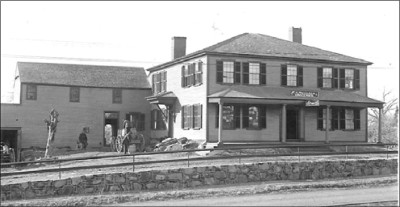
After the American Revolution the number of taverns nearly doubled with the coming of turnpike toll roads. The Blue Hill Turnpike (today's Rte. 28) was laid out as an 8 mile stretch through the Blue Hills "from Randolph meetinghouse...to Joseph Babcock's, in Milton." The seldom used road was plagued with financial difficulties made worse by travelers who frequently used only one end of the road to avoid the toll. Even with the placement of two half toll gates, one of which was placed by the Blue Hill Hotel/Clark's Tavern (pictured above, see more below), the turnpike still failed. Today the former turnpike is known as Randolph Avenue. At the time the Blue Hill Turnpike was being built, Brush Hill innkeeper Joseph Billings petitioned to have a turnpike established near his inn. Known as the Brush Hill Turnpike, this road also had difficulty collecting revenue with "anyone on military duty, religious duty, coming to or from any grist mill, or on... ordinary business of family concerns" exempt from paying a toll. The former Brush Hill Turnpike is now Blue Hill Avenue. 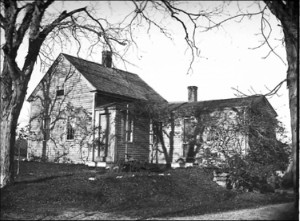
The toll house for the Brush Hill Turnpike (at left) was originally occupied by Mr. McKendry who would turn a gate mounted on a 'pike' allowing travelers to pass after paying a toll. After toll collections ceased, the toll house became a dwelling, which for many years was home to the Sumner family. Katherine Sumner Gould was the last of the family to occupy the house before it was demolished in 1965. During a period of unbridled drinking known as the 'Roaring Forties,' concerned Milton citizens formed local temperance groups. In 1847 at Babcock's Hall more than 300 members of the Milton & Quincy Railway Temperance Union pledged "total abstinence for themselves, declaring war on the manufacturer and dealer and seeking to rescue the down and out." By the close of the 19th century, citizens voted to ban 'the sale of intoxicating liquors in the town,' thus bringing to a close the days of Milton taverns. The Blue Bell (Granite House) in East Milton and Clark's Tavern on Randolph Avenue were the last of the Milton taverns to close their doors. "The tavern will compare favorably with the church. The church is the place where prayers and sermons are delivered, but the tavern is where they are to take effect, and if the former are good, the latter cannot be bad." — Thoreau
About 1731 shipwright William Badcock (later Babcock) built a comfortable home for his family 88 Adams Street, not far from the Public Landing, which soon was operated as a public house. Various members of the Babcock family conducted the inn until the property was sold around 1801. Under Dr. Samuel K. Glover (husband of Eunice Babcock and one of its last innkeepers), the first Milton Post Office was conducted in the tavern, with the mail being brought weekly by a carrier on horseback. The tavern which once stood at the corner of Wharf Street was demolished about 1910. Stone steps now mark the site of this once popular public house. Rachel Smith, daughter of Jeremiah Smith and wife of Daniel Vose, provided the following anecdote involving her father (innkeeper Jeremiah Smith) and innkeeper William Babcock. "Early in the Spring (of 1737 or 1738) after Mr. Jeremiah Smith removed to Milton he found an emigrant ship had arrived from Ireland, and as his neighbor, Mr. William Badcock, wanted a domestic, they went to Boston together. Mr. Badcock got his domestic, and Mr. Smith got a bushel of potatoes from the same vessel. Mr. Badcock never having seen a potato was surprised to see Mr. Smith procure so many. When the time for planting came, Mr. Badcock took a few with directions for planting. Mr. Badcock complained to Smith of the ignorance of the Irish help, for he sent her to the field to get some green corn to boil, and she came back and reported that she had dug up a dozen hills, and there was no corn to be found in one of them. Mr. Smith told him the ignorance of the Irish about corn was no more laughable than the ignorance of the Americans about potatoes!" Blue Hill Hotel/Clark's Tavern - 1183 Randolph Avenue 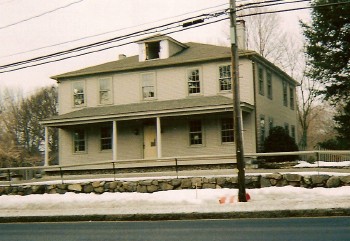 (restoration in 2005)
The Blue Hill Hotel, as it was originally known, was built in 1809 along the new Blue Hill turnpike by Samuel Tucker for his son Joshua Tucker. Minot Thayer purchased the tavern in 1832 which he rented out until his son-in-law William H. Clark eventually took over ownership in 1877. Clark, the last landlord, kept open house until 1888 when the tavern became a private home. In 1907 Harriet (Belcher) Caswell recalled her childhood days at the tavern: 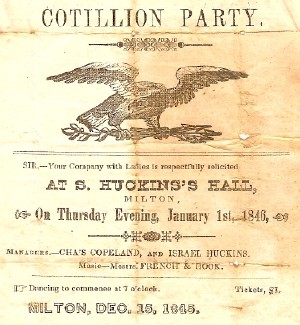
"The old tavern was my home during the best part of my girlhood," recalled Mrs. Caswell in her 85th year, "and it was a place with a great deal of business at that time. Being nine miles from Boston the drovers from Taunton and New Bedford way could stop at the house over night, go on to Boston for their day's business and get back for another night's rest before completing their long journey homeward. My father (Cephas Belcher, son-in- law of owner Minot Thayer), accommodated as many as 30 people at one time. Then it was a favorite tavern for dancing parties from the Lower Mills and from Randolph and even North Bridgewater." The most exciting event in the history of the tavern occurred during the war of 1812. One Saturday a British ship appeared off Boston harbor with the supposed purpose of landing marauding parties. Landlord Major Joshua Tucker received orders to collect his men and be ready to march. Tucker's forces were summoned to the 'tavern in Scott's woods,' to sharpen their swords and to mold bullets; however, the British sailed away without a fight. Today the former tavern is the headquarters of the Copeland Family Foundation. Miller Tavern c.1700 The home and tavern of Samuel Miller — described as "three stories high, stately, and aristocratic" — stood along the King's Highway near Dudley Lane. Mr. Samuel Miller first appeared in Milton about 1688, possibly led here by the attractions of Miss Rebecca Belcher and sixty acres of land on Milton Hill, all of which became his at the time of their marriage. Innkeeper Miller's hospitality was enjoyed by Judge Sewall who recorded in his diary that he "baited at the half moon at Miller's". Innkeeper Miller later built a new home for himself on his Blue Hills land in the Scott's Woods section of Milton; and may have given his tavern on the King's Highway to his son Joseph who is listed as a Milton inn-holder in 1738. The Scott's Woods property, which remained in the Miller family until 1776 when Loyalist Stephen Miller moved to New Brunswick, may also have been home to a tavern. 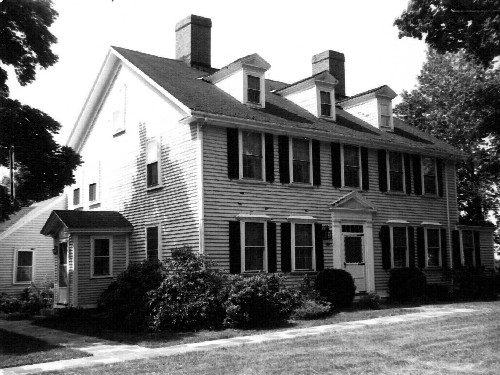 1770 Stephen Miller House, 11 Hillside Street (replaced Samuel Miller House which burned 1770) By 1830 when Benjamin Dudley built his home on Adams Street, no trace remained of the 'stately and aristocratic' Miller Tavern. JEREMIAH SMITH TAVERN 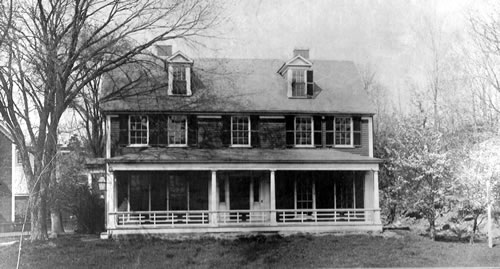 Smith House renovated by Dr. Ware Jeremiah Smith, a native of Northern Ireland, moved to Milton in 1737 to take charge of the paper mill on the Neponset River at Milton Lower Mills. A few years later Smith purchased the property, which contained a dwelling and 7 acres of land, from the Belcher heirs. His home was conveniently situated just south of the Neponset River bridge, where Extra Space Storage Co. is now located. In 1759 Smith received a license to operate his home as a public house after nearby innkeeper “…William Badcock was unable to entertain all the travel.” Historian Edward Hamilton believed that the Smith house, renovated by Dr. Ware in the early 1800s, survived until demolished by Walter Baker & Co. in 1901. DANIEL VOSE INN According to genealogist Ellen Vose, Daniel Vose and his cousin Joseph Fenno bought land together, where they lived and erected buildings, where they carried on varied trade for a number of years, and conducted their house as an inn. Following the death of Joseph Fenno, Daniel Vose bought out his cousin’s interest. In addition to being a successful merchant, Vose owned the only distillery of record in Milton and was licensed to sell liquor and operate a store on the first floor of his home. Being a savvy businessman, Vose used his distillery as a link between his tavern and his ships laden with goods which he sold in his store. The home of Daniel Vose was enlarged by son-in-law Dr. Amos Holbrook, who moved the house from its original location at the corner of Adams & Wharf Streets to 40 Adams Street, where Citizens Bank is now located. In 1950 the house, which was in poor condition, was moved to 1370 Canton Avenue courtesy of Dr. & Mrs. James B. Ayer who restored the house with architect-engineer William Morris Hunt. The house, now the headquarters of the Milton Historical Society, takes a prominent place in American history as the site where the Suffolk Resolves were signed on September 9, 1774. Milton historian (and Vose descendant) Col. Edward P. Hamilton humorously noted that when the savings bank was constructed on the former site of the Suffolk Resolves house “almost immediately tremors and cracks were noted in the vicinity of Daniel Vose’s tomb.” Mrs. Ayer bequeathed this historic house to the Milton Historical Society in 1963. Ten years later the Suffolk Resolves House was added to the National Register of Historic Places. VOSE INN (AKA GREEN DRAGON TAVERN & RISING SUN TAVERN) In 1767 Samuel Vose bought a small corner lot at Adams Street and Canton Avenue where he built an inn which he operated with his brother-in-law Joseph Cummings, who briefly held half interest in the property. Vose later sold the property to Dr. Samuel Glover who rented it to Henry Vose. For several years Vose operated it as the “Green Dragon Tavern.” He had previously welcomed guests at his wife’s family home, the popular Billings Tavern before opening a tavern at Milton Lower Mills. Following his success with the ‘Green Dragon,’ Henry moved his tavern operations to Boston. When the inn was purchased by Moses Whitney it became known as the “Rising Sun.” After remodeling the property in 1840, Whitney gave the old tavern sign to carpenter William Billings of Canton, who gave it to Elijah Morse who adopted “Rising Sun” as the trademark for his world famous stove polish.
By 1900 the former tavern had been remodeled by the Gordon family for business use with rooms for rent above. Apartments were still being occupied until shortly before the structure was demolished in 1954.
Today Dolan Chapman Funeral Home stands on the site of the former tavern at 5 Canton Avenue. GLOVER TAVERN Around 1800 Dr. Samuel Glover built a tavern on Badcock land inherited by his wife. It was stated that innkeeper Glover had only one failing, he would ‘partake overmuch’…perhaps an occupational hazard! After nearly 20 years of successful stagecoach inn operations, Glover decided to give up his tavern license when the stage was sold. Following the deaths of Dr. Glover and his son, the estate was purchased by China Trade Captain Edward H. Faucon who remodeled the former tavern in 1865 as a private home. Author Richard Dana in Two years before the Mast chronicles a voyage he made under the command of Captain Faucon. In 1936 the tavern structure was demolished when the current 144 Adams Street residence was built. BROWN TAVERN Not long after his marriage to Molly Gooch, Josiah Brown purchased land on the opposite corner of Adams Street and Churchill’s Lane from his father-in-law on the bustling King’s Highway where he built his tavern in 1768. Often called a ‘favorite rendezvous in the Revolution,’ the tavern stood atop Milton Hill where it offered commanding views of both the Neponset River and the Blue Hills.
Unfortunately Mr. Brown, an impassioned Revolutionary orator, died at the age of 35 leaving his grieving widow “5 beds & bedding to keep tavern with.” After a suitable period of mourning his widow Molly married Capt. Levi Rounseville, who became the next landlord, a position he held until the couple left Milton. It is believed that the tavern was later rented to Samuel Robinson who hosted a celebration of General Washington’s Birthday at his Milton inn in 1782. According to tradition a banquet of roast turkey, followed by 13 toasts, was enjoyed by all and that a celebration of Washington’s Birthday was continued in Milton before it was commonly practiced.
By the time the five-acre Brown property at the corner of Churchill’s Lane and Adams Street was purchased by Captain R. B. Forbes about 1824, the tavern was no longer standing. Today the Forbes House Museum grounds mark the site of the former tavern. GOOCH TAVERN About 1743 Colonel Joseph Gooch constructed a Colonial home for his family on the King’s Highway, which may have operated as a tavern according to this July 20, 1765 entry from The Diary of John Rowe which states that Rowe “…went to fish with friends at a pond ‘beyond the Blue Hill’ and put up at Mr. Joseph Gooch…” However according to an entry penned by President John Adams in his Diary, Col. Gooch, it seems, was not universally liked: Following the death of Col. Gooch his home was rented out by daughter Molly’s husband and tax records suggest that it continued to be operated as a tavern for several years. The home of Col. Gooch still stands at 233 Adams Street. DANIEL TAVERN The first tavern in Milton was established by William Daniel, shortly after leaving Dorchester in 1646, on a 13 acre lot on the north side of Milton Hill (halfway between Dudley Lane and Algerine Corner). Here he built his home which he also operated as the first public house in Milton. Town records show that the Selectmen and militia officers frequently dined and wined at his ordinary; and that in 1678 he was licensed to sell beer, cider and wine, but not ‘strong water’. However an unfortunate incident which took place in 1685 between two men traveling to Boston who stopped at the Milton ordinary to quench their thirst is related in Early Court Files. After refreshing themselves John Baxter and Thomas Saffin, Jr. got into a drunken brawl 250 yards from the house which resulted in a terrible mauling, beating and kicking of horse and rider graphically described in the court record. In 1733 Provincial Treasurer William Foye bought the Daniel estate, removing the old tavern to erect a stately mansion, which has since been demolished, at 320 Adams Street. PIERCE TAVERN Revolutionary War Capt. Rufus Pierce built his gambrel-roofed cottage on the King’s Highway in East Milton. Completed after the war, it was conducted as a tavern for many years by Capt. Pierce, who was the grandson of Milton innkeeper Joseph Bent. After the death of Capt. Pierce the cottage was passed down in the family, and eventually inherited by Henry Sheldon. In 1893 a Library Reading Room was briefly kept here after a fire destroyed the one in East Milton. Several years later the former tavern was removed and two large homes (478 & 486 Adams Street) were built by the Sheldon family on the property. One of the Sheldon homes was removed for the construction of the Southeast Expressway; and the other was demolished when the Sheldon Building (now Jesson Building) was built. The building’s parking lot marks the site of the tavern. RAILWAY HOUSE The “Railway House” was built about 1826 as a lodging house with stables for the Granite Railway Company. It was often filled with visitors from the city who came to see the country’s first railway. A large hall for dancing, excellent meals, and first class accommodations offered guests a comfortable stay. It was often a popular site for a dance, such as this Thanksgiving Ball given in 1841. While attending Harvard author Owen Wister often frequented the Railway House, which he called the “Bird-in-Hand” in his novel Philosophy 4.” Describing the tavern as “…to the undergraduate of that day, ... was what the Golden Fleece used to be to the Greeks… It was reported to be somewhere in the direction of Quincy, but for the successful explorer, a dinner and wines were waiting… more delicious than anything outside of Paradise…” Mary Phillips Webster, granddaughter of Col. Thomas Hollis, President of The Granite Railway, shared her childhood memories of the Granite House: “I remember the plan of the old granite house, the anterooms at each side of the front door, the long parlor in the west wing, which had been the hotel dining-room, the sitting room in the east wing, the great hall over the long ell, the wonderful Diana grapevine which filled the sunny southeast corner between the house and the ell. Two of the old bowling alleys of the hotel still remained at the rear of the house and a little distant from it. One of these Grandfather had fitted up as a grapery… Grandfather had a pear orchard too, at the east side of the house where Edge Hill Road now is.” By the late 1800s the tavern was operated as the Granite House, a successful boardinghouse and tea room. Unfortunately, hard times followed and the property was put up for sale. In 1923 the struggling Granite House advertised its furnished rooms and restaurant featuring Italian & American cuisine; however, following year the stone structure was demolished. In 1929 the south half of the property was offered to the Town by Nathaniel Kidder as a site for an East Milton Library and several years later the East Milton Post Office was built on the north portion. Surprisingly the last dance held on the property was in 1937 when the Post Office was dedicated. BENT & BRADLEE TAVERN The Bent Tavern, which stood beneath a large elm on the old Taunton road (Canton Avenue today), was built around 1725 by Joseph Bent who began to keep inn after his marriage to Martha Houghton. After more than thirty years of keeping tavern, military duty called Captain Bent to New York where he died. His hostelry duties were then assumed by his son. ATHERTON INN After the Bradlee tavern was sold widow Sarah Bradlee married the new owner of the property, Major Jedidiah Atherton. Several years later the Major decided to tear down the old tavern, replacing it with a new four-square one known as the Atherton Inn. Located at the junction of Atherton Street and Canton Avenue the inn was a popular stop for the bustling stagecoach traffic on the old Taunton Road. The Atherton, which offered a large second-story dancing room as well as space to accommodate overnight guests and regulars, often boarded long term guests including Jesse Pierce, during his teaching days at the “Old Brick” school. The former inn, significantly altered by additions and renovations, still stands at 1253 Canton Avenue. By the early 1700s Joseph Billings and his wife were conducting a public house on the old Taunton Road not far from Great Blue Hill. Several generations of the family operated the popular inn known for its fancy dinners, parties, dances, and summer boarders. The Billings tavern was also the birthplace of Patience Billings, the mother of Daniel Vose. In 1798 the Billings family decided to build a scenic observatory on nearby Great Blue Hill for the enjoyment of its guests. A 3 story wood structure with plank seats and railings on the outside and stairs on the inside was built by neighbors while tavern patrons contributed to its cost. Nearly a century later the ruins of the lookout were removed when Abbott Lawrence Rotch built his Blue Hill weather observatory. “The Tavern, boardinghouse and fruit gardens of Mr. Billings, is one of the most delightful summer retreats in the neighborhood of Boston” boasted the 1828 Massachusetts Gazetteer. After more than 100 years of family operation the tavern was sold to Moses Gragg who ran it as the Blue Hill Tavern for 20 years. Gragg, it was said, kept his stable cleaner than most women kept their kitchens. The Blue Hill tavern sign of innkeeper Gragg is in the collection of the Dedham Historical Society. When the tavern was sold in 1849, the hotel probably reverted to its original name as social assemblies were advertised in ‘Billings Hall,’ a later addition to the structure. In 1885 when the former tavern was demolished, it was said to be one of the oldest buildings in Milton. Today the large summer house subsequently built by the Wainwright family still stands at 1661 Canton Avenue. LEMUEL DAVIS INN
Around 1775 Lemuel Davis built a tavern on Hillside Street in Scots Wood on land acquired from Samuel Tucker. Although historian A. K. Teele states that the tavern was owned earlier by a man named White. A search of records has not been able to confirm that anyone named White owned the property; however, it is possible that the property was rented to White.
Fifteen years later Lemuel Davis decided to build a new home for himself at 386 Highland Street, which may also have been used as a tavern. The structure was partially demolished in 2011 when a 2 large story addition was added. Following the death of Lemuel Davis his son-in-law Elijah Wild came into possession of the Hillside Street property, which was sold in 1832 to Lewis Copeland who used it as a residence. In 1876 Charles Copeland moved the former tavern to the west side of Randolph Avenue; however, the structure was ultimately demolished around 1899 when the street was widened to accommodate a short-lived street railway. WHITE TAVERN In 1686 Peter White received a license to conduct a public house in Milton which he operated for the next 50 years. Records indicate that it was located on the “northwest corner of White Street (Reedsdale Road today) and the extension of Central Avenue from Brook Road to Thacher Street.” A 1762 deed reveals that the property contained 38 acres, a house and buildings. KENNEDY TAVERN Little is known of the tavern kept by Andrew Kennedy in Scott’s Woods during the American Revolution, save that it stood on the land of John Pitcher. The tavern was described in a deed as ‘the old house on the NW side of the road’ (Hillside Street today) and was likely located near Harland Street. PITCHER TAVERN The only reference found to the tavern of Samuel Pitcher comes from Canton historian D. T. V. Huntoon, who wrote that Samuel Pitcher was lame and kept a tavern in Milton in 1712. By 1717 Pitcher had obtained dismissal from the Milton church and had applied for admission to the church at Stoughton. His descendants believe that the tavern would have stood near his tanning operation which was in the valley opposite the First Parish Church in Milton on Canton Avenue. WILLIAM PIERCE TAVERN
Capt. William Pierce was keeping an inn in Milton by at least 1736 according to Early Court Files. Home of Capt. William Pierce in Milton was described as “near bounds of the town extending that way from road about Ben Beals in Braintree (Quincy) to the road about Mores Bridge.” Historian Bill Loughran, who did extensive research on the Launcelot Pierce house, felt that it was probably built by Launcelot’s father Capt. William Pierce who operated it as an inn. KINSLEY TAVERN According to 1744 and 1747 Early Massachusetts Court Files Samuel Kinsley was a licensed Milton innholder. It is believed that his tavern was probably on the King’s Highway (Adams Street), not far from the Daniels Tavern. No additional information on his tavern has been found. BLAKE TAVERN Boston Records show that William Blake (1620-1703) was licensed in 1670 “to keep hous of publique entertainment.” In 1660 William Blake become the proprietor of a lot of land (then territory belonging to Dorchester) which reached from Canton Avenue over Brush Hill to the Neponset river. In 1662 his land became part of Milton following its incorporation. According to Early Suffolk County Court Files, in 1682 William Blake of Brush Hill in Milton was licensed to keep a house of entertainment for travelers on the new road from Taunton over Brush Hill. Blake, a farmer by occupation, was also a Selectman and Deputy to the General Court. The last reference to his innkeeping was May 12, 1691 when the County Court granted Blake permission to keep ‘an house of Entertainment’ at Brush Hill for the upcoming year. In 1789 the western part of the Blake house was damaged by lightning and by 1887 the house was no longer standing. According to historian A. K. Teele the tavern stood ‘near the house of Mr. White’ located at 685 Brush Hill Road. WILLIAM DAVENPORT TAVERN C.1787 "On the corner between Canton Av. and Green St. stood the ‘Davenport Store’, famed of old as a halting place for all teams. The thirsty were also refreshed; and as all were thirsty in those days, it so happened that the weary traveler seldom passed this store without a friendly call." (Teele) The c1780 William Davenport house, which was operated by Davenport as a tavern in 1787, still stands at 1 Green Street.
|

